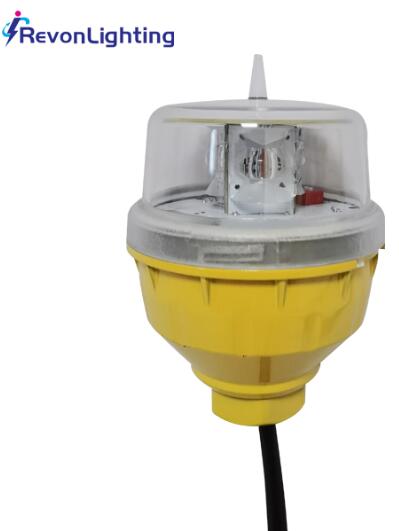Posted: 2024-12-26
Low intensity obstacle lights are critical components in ensuring safety in aviation, construction, and other industries where tall structures pose a risk to air navigation. Designed for marking obstacles at lower heights, these lights provide visibility to pilots and enhance overall operational safety. This article explores the significance, applications, and advancements in low intensity obstacle light technology, shedding light on their indispensable role in various environments.
What is a Low Intensity Obstacle Light?
A low intensity obstacle light is a specialized lighting device used to mark obstacles that may not be easily visible to aircraft, especially during low-light conditions. These lights are commonly mounted on structures such as:
Communication towers
Wind turbines
Antennas
Chimneys
Buildings
Unlike medium or high-intensity lights, low intensity obstacle lights are intended for structures that are shorter or less hazardous to air navigation but still require clear identification.

Key Features of Low Intensity Obstacle Light
Low intensity obstacle lights are characterized by several features that make them suitable for their specific applications:
Energy Efficiency:
Most modern lights use LED technology, ensuring low power consumption and long operational life.
Compact Design:
Their small and lightweight design makes installation straightforward on various structures.
Durability:
Built to withstand harsh weather conditions, these lights are often water-resistant and corrosion-proof.
Compliance with Standards:
Designed to meet international aviation regulations such as ICAO (International Civil Aviation Organization) and FAA (Federal Aviation Administration).
Steady or Flashing Modes:
Depending on the requirements, these lights can operate in steady or flashing configurations.
Applications of Low Intensity Obstacle Light
The use of low intensity obstacle lights spans several industries, enhancing safety and visibility in critical areas:
Aviation Safety:
Installed on buildings and towers near airports or flight paths to ensure that pilots can identify obstacles during takeoff and landing.
Urban Infrastructure:
Used in urban areas to mark lower-height structures, preventing collisions in densely built environments.
Wind Energy:
Mounted on wind turbines to highlight their presence to low-flying aircraft.
Industrial Sites:
Deployed on chimneys, cranes, and similar structures in industrial zones to mitigate risks.
Benefits of Low Intensity Obstacle Light
The adoption of low intensity obstacle lights offers several advantages:
Enhanced Safety:
By marking obstacles effectively, these lights reduce the risk of collisions and accidents.
Cost-Effectiveness:
Their energy-efficient operation and long lifespan translate to lower operational and maintenance costs.
Regulatory Compliance:
Meeting aviation authority standards ensures adherence to legal requirements and avoids penalties.
Eco-Friendly Operation:
The use of LED technology minimizes environmental impact by reducing energy consumption and waste.
Types of Low Intensity Obstacle Lights
There are two main categories of low intensity obstacle lights based on their functionality and brightness levels:
Type A:
Steady-burning lights with lower intensity, suitable for marking less hazardous obstacles.
Type B:
Slightly brighter lights, often used in locations requiring greater visibility.
Both types are used depending on the environmental and operational needs of the site.
Advancements in Low Intensity Obstacle Light Technology
With technological advancements, low intensity obstacle lights have become more reliable and efficient:
Smart Controls:
Integration with IoT systems allows remote monitoring and control, optimizing performance and maintenance schedules.
Solar-Powered Models:
Solar-powered obstacle lights are increasingly popular in remote areas, eliminating the need for external power sources.
Enhanced Visibility:
Improved lens designs ensure better light dispersion, increasing visibility from greater distances.
Self-Diagnostic Systems:
Advanced models come equipped with diagnostic tools that alert operators to potential issues, reducing downtime.
Maintenance Tips for Low Intensity Obstacle Lights
Proper maintenance is essential to ensure the consistent performance of low intensity obstacle lights:
Regular Inspections:
Conduct routine checks to identify any damages or operational issues.
Cleaning:
Keep the light and lens free from dirt and debris to maintain optimal brightness.
Battery Management:
For solar-powered lights, monitor battery health and replace as needed.
Firmware Updates:
For smart systems, ensure software and firmware are updated to utilize the latest features.
Choosing the Right Low Intensity Obstacle Light
When selecting a low intensity obstacle light, consider the following factors:
Compliance:
Ensure the light meets the relevant regulatory standards for your region.
Environment:
Evaluate the environmental conditions, such as temperature and humidity, to choose a durable model.
Energy Source:
Decide between solar-powered or electric models based on the location and power availability.
Warranty and Support:
Opt for products backed by a solid warranty and reliable customer support.
Low intensity obstacle lights are vital for maintaining safety in aviation and urban development. Their role in marking obstacles, preventing accidents, and ensuring regulatory compliance underscores their importance in today’s infrastructure. With continuous advancements in technology, these lights are becoming smarter, more efficient, and increasingly reliable. Choosing the right low intensity obstacle light for your needs ensures not just compliance but also peace of mind, knowing you’re contributing to safer skies and safer spaces.